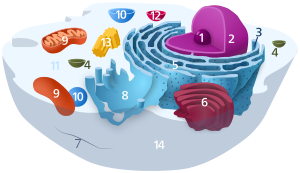Cytoskeleton
| Cell biology | |
|---|---|
| The animal cell | |

Components of a typical animal cell:
|
A cytoskeleton is present in all cells of all domains of life (archaea, bacteria, eukaryotes). It is a complex network of interlinking filaments and tubules that extend throughout the cytoplasm, from the nucleus to the plasma membrane. The cytoskeletal systems of different organisms are composed of similar proteins. In eukaryotes, the cytoskeletal matrix is a dynamic structure composed of three main proteins, which are capable of rapid growth or disassembly dependent on the cell's requirements at a certain period of time.
The structure, function and dynamic behaviour of the cytoskeleton can be very different, depending on organism and cell type. Even within one cell the cytoskeleton can change through association with other proteins and the previous history of the network.
There is a multitude of functions that the cytoskeleton can perform. Primarily, it gives the cell its shape and mechanical resistance to deformation, and through association with extracellular connective tissue and other cells it stabilizes entire tissues. The cytoskeleton can also actively contract, thereby deforming the cell and the cell's environment and allowing cells to migrate. Moreover, it is involved in many cell signaling pathways, in the uptake of extracellular material (endocytosis), segregates chromosomes during cellular division, is involved in cytokinesis (the division of a mother cell into two daughter cells), provides a scaffold to organize the contents of the cell in space and for intracellular transport (for example, the movement of vesicles and organelles within the cell); and can be a template for the construction of a cell wall. Furthermore, it forms specialized structures, such as flagella, cilia, lamellipodia and podosomes.
...
Wikipedia
